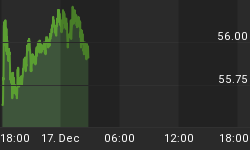After the apparently success of its stimulus program, China's remarkable economic recovery has many observers forecasting an even brighter future for the emerging powerhouse. China's 2008-2009 economic rebound and rising appetite for commodities has made many bullish converts. A close look at some important indicators, however, calls that optimism into question...
China's economic stimulus program created a reported 6.7 million jobs. After its economy bottomed in late 2008, China saw its GDP grow 8 percent in the first quarter and nearly 15 percent in the second quarter of 2009. As one analyst has stated, "This is the earliest and most rapid recovery of any globally significant economy."
China's voracious demand for commodities, particularly industrial metals like steel and copper, has been widely reported. The question, however, is whether China's rising commodity inventories are being consumed or merely stockpiled. As Christopher McMahon observed in his recent Stock Futures & Options magazine article, "Year of the Ox: Is It a Bull for China?", Chinese entrepreneurs and investors are stockpiling copper and other physical metals in a bold speculation on their country's economic future. McMahon pointed out that in 2008, China imported 1.46 million tons of copper compared with 2.4 million tons in the first seven months of 2009.
This rising trend took a dive in July, however, as copper imports fell to their lowest level in six months. It also calls into question whether the anticipated demand for industrial demand on the part of the stockpilers was premature.
Then there is the matter of steel production. There is no denying that China's steel production for 2009 has been on a rip-and-tear. For the latest month in which figures are available, China's steel production was 52.3 million metric tons (mmt), an increase of 22 percent from the year-ago period. This compares to U.S. production of steel at a paltry 5.2 mmt, a 40 percent drop from the year ago figure.
Yet much of China's steel production is attributed to its government sponsored stimulus program, which involves new construction of roads, bridges and other infrastructure, much of it dedicated to repair work from last year's earthquake in the Sichuan province. The well known economist Steven Roach, chairman of Morgan Stanley Asia, described this massive investment in infrastructure "China's most top heavy and unbalanced sector."
Related to steel production is China's involvement with the molybdenum market. As pointed out in a recent article by Rex Loesby of The Northern Miner, this year's moly price rebound has been called into question due to the uncertainty surrounding China's demand for this important industrial metal, 80 percent of which is consumed by the steel industry to make high-strength steel.
Loesby asks what everyone is currently wondering: whether Chinese buyers have been building inventories or actually consuming the metal. "Anecdotal evidence suggests inventories were being built as Chinese consumers were apparently taking advantage of what they perceived to be low prices for moly. The recent price decline is partially attributed to the fear that these stocks will come back in to the market soon," stated Loesby.
Loesby pointed out that in 2010, increased production from copper mines that produce moly as a byproduct is forecast to increase global production to 471 million lbs., or up 10 percent over 2009 and above the previous all-time record of 467 million lbs. in 2008. "The demand for moly is not expected to keep pace with this estimated production increase," surmised Loesby. "Unless primary producers reduce even more than they have already, oversupply conditions may dominate the market for the next couple of years."
In spite of the prevalence of positive economic data for much of 2009, the China stock sector is looking exceptionally weak right now from a technical standpoint. We've been highlighting the lagging internal condition of the U.S. listed China stocks in recent weeks and it now appears to have reached the breaking point. The internal momentum series of the China stocks known as CHINAMO is now uniformly down across the entire series as you can see here.

The CHINAMO indicators were mostly to the downside through the summer and fall, sending a strongly negative divergence signal against the recovery highs that were made in many U.S.-listed China shares. What makes this time different is that the 10-year cycle has peaked and China stocks will have to find their own internal impetus if they want to remain buoyant from here.
Meanwhile the Shanghai Composite Index has now made a lower high under its August 2009 recovery high. Thus, the Chinese stock market isn't corroborating the positive message of the economic numbers in China so far.

This is a heads-up signal that China could be in for a period of tumult in spite of the bullish sentiment being expressed in the financial press concerning this economic power. Accordingly, it may be time to begin looking askance at the economic data (questionable as it is) and taking a hard look at where China's economy is heading in 2010.















